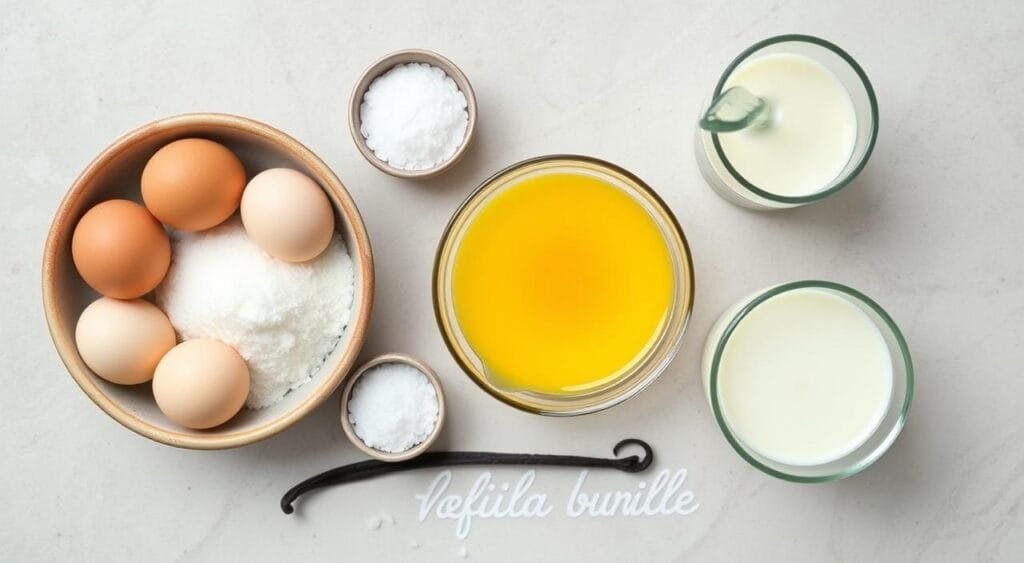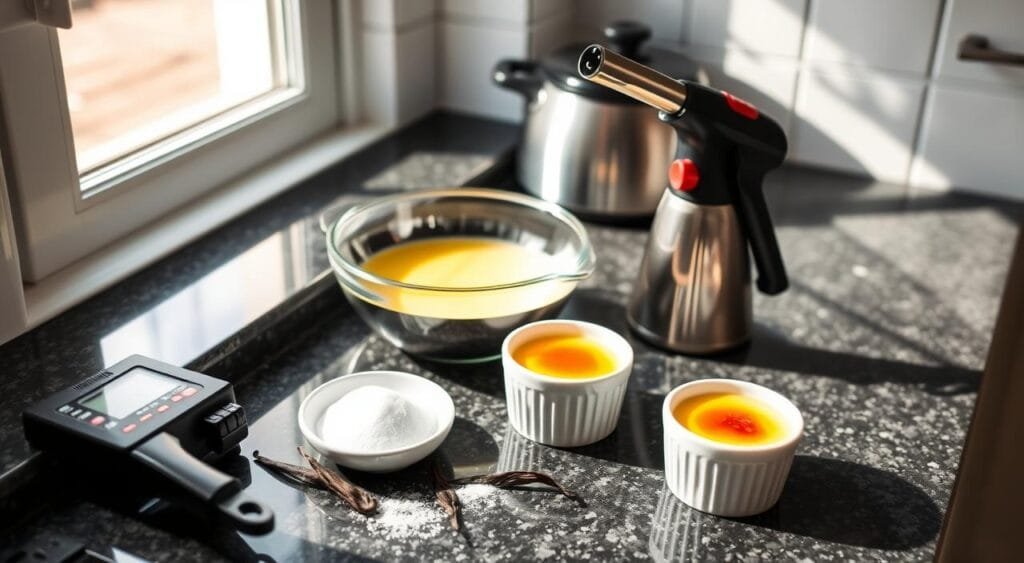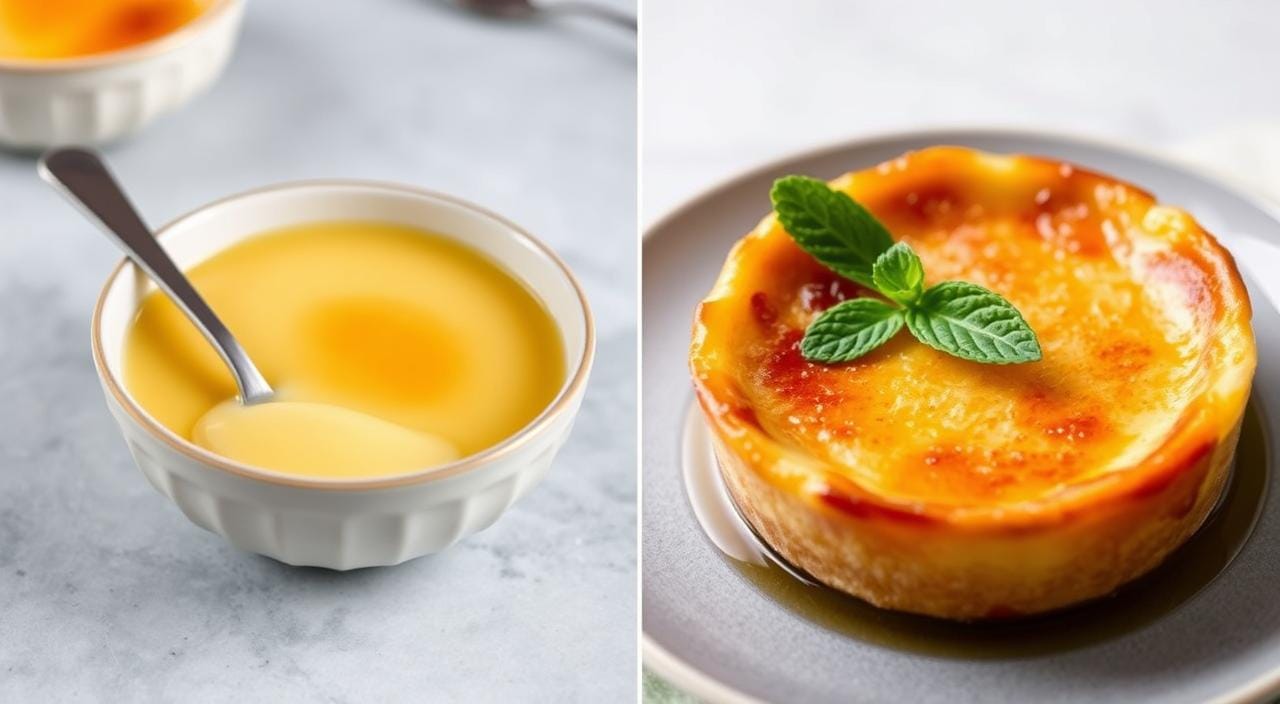The smell of vanilla and caramelized sugar fills the air, reminding me of a Parisian café. The golden crust of crème brûlée, with its silky custard, is irresistible. It’s a French dessert loved by many.
But what makes crème brûlée special compared to custard? We’ll explore this in detail. We’ll look at its history, ingredients, and how it’s made. This will reveal why it’s a classic.
Are you ready to explore crème brûlée and custard? Let’s start this tasty journey together. Get ready for a mix of textures and a rich, creamy custard.
Understanding Basic Custard Desserts
Custard-based desserts are a wide range of tasty treats. They include the famous crème brûlée and the smooth flan. Even though these custard recipes start with similar ingredients, how they’re made and presented makes each one unique.
Types of Custard-Based Desserts
Some well-known custard-based desserts are:
- Crème brûlée – A French dessert with a caramelized sugar crust on top of a rich, baked custard base.
- Crème caramel – Also known as flan, this custard features a soft caramel sauce on the bottom.
- Clafoutis – A simple French dessert where fruit is baked into a custard-like batter.
- Zabaglione – An Italian custard made with Marsala wine, often served warm.
- Bread pudding – A comforting dessert that repurposes stale bread in a custardy mixture.
Key Components of Traditional Custards
The core of these custard desserts are milk, sugar, and eggs. The exact amounts and how they’re mixed can change, but together they create a creamy texture and deep flavor.
“Eggs are a primary thickening agent in custard desserts instead of flour or starch powders.”
How custards are thickened can also vary. Some use eggs, starch, or gelatin. This focus on detail is what makes each baked custard and custard-based treat special.
The Origins of Crème Brûlée: A French Delicacy
Crème brûlée, a favorite French dessert, has a long history. It started in the 17th century at the Palace of Versailles. Chef François Massialot, working for Louis IX, created this creamy custard with a caramelized sugar topping.
The name “crème brûlée” means “burnt cream” in English. It perfectly describes the dessert’s caramelized sugar layer on top of the creamy custard. This French dessert has won the hearts of many dessert lovers, showing off indulgence and culinary skill.
The first known recipe for something like crème brûlée is in Massialot’s 1691 book, Cuisinier royal et bourgeois. But it wasn’t well-known for a long time. It became popular in the 1980s, appearing on fancy restaurant menus everywhere.
“Crème brûlée became extremely popular in the 1980s, a symbol of that decade’s self-indulgence and the darling of the restaurant boom.”
Sirio Maccioni, owner of Le Cirque in New York, helped make crème brûlée famous. He said it was “the most famous and by far the most popular dessert in restaurants from Paris to Peoria.”
Now, crème brûlée is still loved and shows the lasting charm of French cuisine. Its creamy custard and caramelized sugar topping still excite food lovers everywhere.
Essential Ingredients and Proportions
The ingredients you choose are key to making crème brûlée and custard. They affect the texture and taste of these desserts. Let’s explore the main parts that make these treats so special.
Heavy Cream and Egg Yolks in Crème Brûlée
Crème brûlée gets its creamy texture from heavy cream and egg yolks. Heavy cream adds a rich flavor and smooth feel. Egg yolks make the custard smooth and creamy, making it a treat to eat.
Milk and Whole Eggs in Traditional Custard
Traditional custards mix milk and whole eggs. Milk gives a lighter texture, while whole eggs make it smooth. This mix makes custard less thick and more velvety than crème brûlée.
Sugar and Vanilla Components
Sugar and vanilla are added to both crème brûlée and custard to boost flavor. Crème brûlée uses more sugar for its caramelized top. Vanilla, from beans or extract, adds a warm, aromatic taste that goes well with the dairy.

The ingredients and their amounts greatly affect crème brûlée and custard. Knowing this can help you make the perfect dessert. Whether it’s a classic crème brûlée or a smooth custard, you’ll get it right.
What’s the difference between crème brûlée and custard?
Crème brûlée and custard may look similar, but they are not the same. They differ in ingredients, how they’re made, and how they look. Knowing these differences helps us enjoy each dessert’s special qualities.
The main difference is in the base. Crème brûlée has a creamy custard made from heavy cream, egg yolks, and sugar. It’s topped with a crunchy caramel sugar layer.
Custard, however, can be many things. It’s a dessert on its own, a filling, or part of other treats. It’s made from milk, eggs, and sugar, giving it a smooth texture.
- Crème brûlée is cold, with the caramel sugar adding a nice crunch.
- Custard can be warm or cold, and is often in a pie or on its own.
Making crème brûlée is a precise process. It involves tempering egg yolks and baking carefully. The sugar topping is caramelized with a torch or broiler.
Custard, though, can be made in many ways. It’s cooked on the stovetop, in the oven, or even in the microwave. It needs careful watching to get right.
“The key to a perfect crème brûlée is all in the balance of the custard and the caramelized topping. It’s a delicate dance that requires precision and patience.”
Both crème brûlée and custard are wonderful desserts. They offer different tastes and textures. Whether you like the caramel top of crème brûlée or the creamy custard, you’ll find something to love.
The Art of Making Crème Brûlée
Making crème brûlée is a fun dance in the kitchen. It mixes a creamy custard with a crunchy caramelized top. This French dessert is famous for its smooth custard and crunchy sugar crust.
Preparing the Custard Base
The custard base is the heart of a great crème brûlée. It’s made by mixing heavy cream, whole milk, sugar, and egg yolks. The mix of whole milk and heavy cream makes it rich and creamy. Egg yolks help it thicken.
Baking it in a water bath cooks it evenly. This way, it stays smooth and silky.
Creating the Perfect Caramelized Top
The top of crème brûlée is the caramelized sugar topping. It’s golden and crunchy. To make it, sugar is caramelized on top of the chilled custard.
Using a kitchen torch or broiler, the sugar melts and turns golden. This creates a crunchy layer that cracks with each bite.
The secret to great crème brûlée is balancing the custard and caramelized top. With care and precision, you can make a dessert that looks and tastes amazing.
“The first printed recipe for crème brûlée can be traced back to the 1693 French cookbook ‘Cuisinier Royal et Bourgeois’ by François Massialot.”
Traditional Custard Preparation Methods
Making a tasty custard recipe or baked custard needs careful mixing of ingredients and cooking techniques. Traditional custards are known for their smooth texture. This comes from a detailed cooking process.
A classic custard starts with milk, sugar, and eggs. These are mixed and heated slowly until thick and creamy. The custard can be baked in ramekins or a pie crust, making different desserts.
For crème caramel, a caramel layer is made first. Then, the custard is poured on top. This adds a sweet caramel top, enhancing the dessert’s taste and texture.
The exact mix of ingredients and cooking methods vary by custard type. Some use more egg yolks, while others use more milk or cream. The baking temperature and time are also key to getting the right feel and taste.
“The key to a perfect custard lies in the careful balancing of its core components – milk, sugar, and eggs. With the right technique and attention to detail, you can create a custard that is both silky smooth and bursting with flavor.”
Whether it’s crème brûlée, crème caramel, or simple baked custard, knowing the traditional ways is crucial. It helps make these desserts just right.
Texture and Consistency Comparisons
Egg-based desserts like crème brûlée and custard have different textures. Crème brûlée has a creamy base and a caramelized sugar top. When you crack the caramel, it’s a special treat.
Custards, on the other hand, are smooth all the way through. They can be firm or silky, depending on how they’re made. Using whole eggs makes custards denser and richer.
Crème Brûlée’s Signature Crack
The caramelized sugar on top of crème brûlée is key. It’s made by sprinkling sugar on the custard and then caramelizing it with a torch. This creates a contrast between the creamy custard and the crunchy sugar.
Custard’s Smooth Finish
Classic custard desserts, like pot de crème, are smooth all the way through. They use whole eggs for a denser texture. Without caramel, the custard’s smoothness is the main focus.
“The smooth, creamy texture of custard is the perfect canvas for showcasing classic dessert variations.” – Renowned Pastry Chef, Julia Child
Both crème brûlée and custard offer unique textures. They provide a delightful experience for anyone who tries them.
Serving Temperatures and Presentation
Classic French desserts shine with the right serving temperatures and presentation. Crème brûlée is a prime example. It’s served chilled, with the caramelized top added just before serving. This keeps the crispy top and the smooth custard below in perfect harmony.
Crème brûlée is best cold, but custards can vary. For instance, you serve crème caramel at room temperature. You flip it onto a plate, allowing the caramel sauce to flow over the custard. Other desserts, like flan or crème anglaise, come in ramekins, showcasing their creamy texture.
The presentation of French desserts is an art. Adding garnishes like fresh berries or chocolate shavings can enhance both taste and look. By focusing on temperature and plating, your desserts will delight both the palate and the eyes.
“The devil is in the details when it comes to serving French desserts.”
Equipment and Tools Needed
Making the perfect crème brûlée recipe or custard recipe needs the right tools. You’ll need everything from baking dishes to torches. The right equipment makes a big difference in how your dish turns out.
Ramekins and Baking Dishes
Ramekins are key for crème brûlée. They’re small, round dishes that help cook evenly and control portions. For crème brûlée, use 4 to 6 ramekins, each about 7 ounces. You can also bake custards in a big dish or ramekins, depending on what you like.
Torches and Alternative Methods
A kitchen torch is needed for the caramelized top of crème brûlée. It melts and caramelizes the sugar evenly. If you don’t have a torch, you can use a hot broiler for a few minutes. Just watch it closely to avoid burning.
A water bath, or bain-marie, is also important. It’s used for both crème brûlée and custards. It helps cook the custard evenly and prevents it from curdling or drying out.

You’ll also need a spouted bowl or pitcher for pouring, a fine-mesh sieve for straining, and a whisk for mixing ingredients.
Common Mistakes to Avoid
Making the perfect custard or crème brûlée needs care and focus. Steer clear of common mistakes that can ruin your dessert. Overcooking can make the custard or caramel topping turn bad, leading to a curdled or grainy texture.
When making crème brûlée, don’t put the caramel on a warm custard. It will melt and not look even. In custard making, not tempering eggs right can cause them to scramble. It’s important to control the temperature and use the right technique for smooth textures.
- Prevent overcooking to avoid curdling or a grainy texture.
- Apply the caramel topping to a chilled crème brûlée custard for a crisp, even finish.
- Temper the eggs carefully when making custard to avoid scrambling.
Learning these key techniques can make your custard and crème brûlée even better. Being patient and precise is the secret to making these desserts truly special.
“The difference between custard and crème brûlée is all in the details.”
Popular Variations and Modern Interpretations
Modern twists on classic desserts like crème brûlée and custards are gaining fans. Flavors like chocolate, pumpkin, and pistachio add new dimensions to the French delight. Custard desserts now come in many flavors, including gluten-free and fusion styles.
These desserts are perfect for trying new things. You might enjoy a chocolate crème brûlée or a custard with saffron. They’re loved by many in the US for their rich flavors.
The love for these desserts shows in their lasting appeal. They’ve become symbols of American and global dessert culture. Their timeless charm and the creativity in making them keep them beloved.

